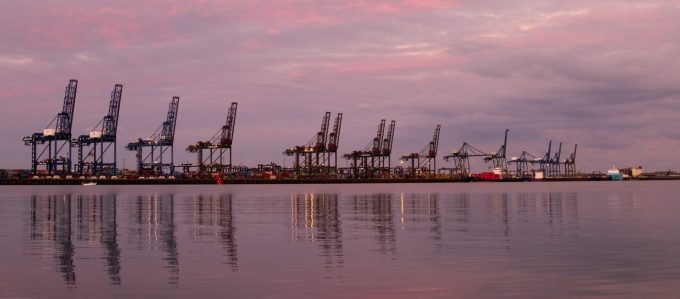Bangladesh looks at demurrage waiver as containers pile up in Chittagong
The Chittagong port yards now have close to 40,000 teu of containers, mainly loaded with ...
TFII: SOLID AS USUALMAERSK: WEAKENINGF: FALLING OFF A CLIFFAAPL: 'BOTTLENECK IN MAINLAND CHINA'AAPL: CHINA TRENDSDHL: GROWTH CAPEXR: ANOTHER SOLID DELIVERYMFT: HERE COMES THE FALLDSV: LOOK AT SCHENKER PERFORMANCEUPS: A WAVE OF DOWNGRADES DSV: BARGAIN BINKNX: EARNINGS OUTODFL: RISING AND FALLING AND THEN RISING
TFII: SOLID AS USUALMAERSK: WEAKENINGF: FALLING OFF A CLIFFAAPL: 'BOTTLENECK IN MAINLAND CHINA'AAPL: CHINA TRENDSDHL: GROWTH CAPEXR: ANOTHER SOLID DELIVERYMFT: HERE COMES THE FALLDSV: LOOK AT SCHENKER PERFORMANCEUPS: A WAVE OF DOWNGRADES DSV: BARGAIN BINKNX: EARNINGS OUTODFL: RISING AND FALLING AND THEN RISING

Although not nearly compensating for Felixstowe’s huge loss of business due to severe disruption caused by a disastrous migration to a new terminal operating system in June, the port appears to be starting to win back some lost services.
Hapag-Lloyd has advised that its European Mediterranean Express (EMX) service, which it operates in partnership with OOCL, is to return to UK’s biggest container port with the arrival of the 4,250 teu Heron Hunter on 23 December.
The final vessel on the EMX to sail from Southampton will be the CPO Baltimore, which is a similar-sized panamax vessel, on 15 December.
When OOCL announced in August that the service, which it dubs its NET (North Europe-Turkey), was leaving Felixstowe for Southampton it heavily criticised Hutchison-owned Felixstowe’s malaise.
At that time, it said in a customer advisory: “Felixstowe Terminal continues to suffer with severe operational delays, both shipside and landside, following the introduction of the new terminal IT system nGen.”
The carrier continued: “We’ve reached a point where we can no longer tolerate delays, which not only impact our UK customers but also those connecting at other ports in the service rotation.”
After initially publishing weekly updates on its website after the operating system had been activated, the port suddenly silenced all communication a few weeks later, leaving customers – carriers, forwarders and hauliers alike – angry and frustrated.
One major container haulier told The Loadstar recently that delays to trucking at Felilxstowe had brought the industry in the UK to the verge of collapse.
“I have looked at every which way I can to sue Felixstowe for the damage the port has done to the business since June and it transpires that the only contractual relationship that hauliers have with the port is through the VBS, and that is so heavily weighted in favour of the port that I’ve been advised it is impossible to get anywhere with a legal challenge,” he said.
Another insider at the port told The Loadstar that during the summer the situation had become “absolute chaos”, with data having to be input manually cutting productivity by around 50%.
“Working the vessels is the biggest problem,” said the source, adding that ships were having to “cut and run, and not even able to load empties”.
Many carriers eventually lost patience with the port and transferred several Felixstowe-calls to other UK ports, including Southampton, London Gateway and Liverpool, as well as omitting direct UK calls on some voyages for relay via feeder.
However, DP World Southampton’s decision to accept diverted ships from the Suffolk port exerted “impossible pressure” on its container facility.
Indeed, one large forwarding customer of the port told The Loadstar that the situation was “absolute carnage”.
The problems at Felixstowe and Southampton in the peak season months caused severe delays for UK imports to compound the problems of a chronic shortage of haulage.
Meanwhile, at Felixstowe, perhaps the small victory of wining back a mid-sea service will encourage other disgruntled customers to return and thus awaken the port from its media communication lock down.
Comment on this article